Answer these simple questions and we will find you the BEST prices
Which type of solar quotes do you need?
It only takes 30 seconds
100% free with no obligation

Get Free quotes from insulation specialists near you

Save money by comparing quotes and choosing the most competitive offer

The service is 100% free and with no obligation
- GreenMatch
- Insulation
- Wall Insulation
Wall Insulation: Everything You Need to Know

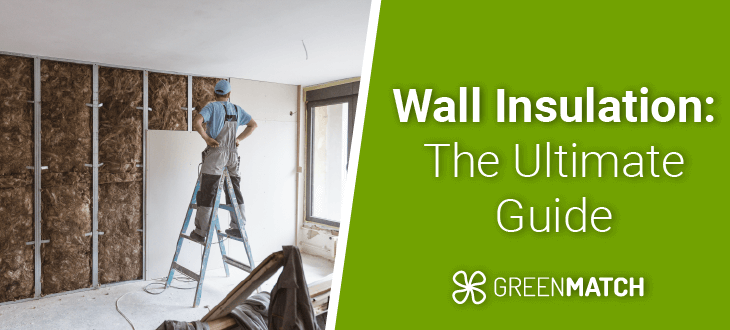
- Uninsulated walls can account for up to 33% of heat loss in a home.
- Wall insulation can save up to £380 on annual energy bills for standard semi-detached homes in the UK.
- Proper wall insulation can reduce your household's CO2 footprint by up to 0.9 tonnes
It’s no secret that the UK housing market needs to be more energy efficient. As it stands, an astonishing 27% of the UK’s total carbon emissions stem from domestic energy alone. The biggest reason is poor home insulation, but perhaps the largest culprit of the batch is uninsulated walls, accounting for one-third of a home's heat loss.
Wall insulation is an essential component of any home's heat-retaining capability and eco-friendliness. It helps maintain a stable and comfortable indoor temperature by slowing down the loss of heat through walls. This in turn leads to massive CO2 reductions, energy bill savings, and a comfortable living environment for decades to come.
In this ultimate guide, we will walk you through everything you need to know about getting wall insulation for your home, complete with types, materials, wall insulation costs, savings and grants.
Ready to slash your bills and carbon footprint with wall insulation? Let GreenMatch UK help you out. With our trusted network of professional installers, we can ensure that you get the best bargain for the job. Simply fill out our 30-second online form, and receive up to 3 free quotes, tailored to your home. No extra charges and no obligations apply. Click below to begin!
- Describe your needs
- Get free quotes
- Choose the best offer
It only takes 30 seconds



Why should walls be insulated?
Wall insulation is perhaps the most effective and important insulation upgrade you could invest in to better your home. This is seen in the host of advantages that come with it, each that will improve your financial security and home environment.
Here are just some of the key benefits you could expect:
- Lower energy bills: The soaring bills you receive each month are likely due to your heating system constantly trying to top up lost heat. Proper wall insulation reduces how often your heating system needs to work, saving you up to £280 - £380 on annual energy bills in a 3-bedroom semi-detached UK home.
- Greener planet: The UK housing stock emits more CO2 than all of the cars in the country combined! Insulating your walls means your heating system doesn’t need to work as much to regulate temperature, reducing your carbon footprint by up to 0.9 tonnes.
- Better home health: Draughty uninsulated homes are a breeding ground for dampness, mould and structural damage. Alongside harming your investment in the long run and racking hefty repair bills, the cold and damp environment will negatively impact your health, increasing respiratory illnesses and susceptibility to flu.
- Higher property value: Insulating your walls will bump up your Energy Performance Certificate (EPC) rating, making your home much more valuable and attractive on the market should you ever plan to rent or sell it.
What are the most common methods of wall insulation?
The most common types of wall insulation available to you will largely depend on the type of wall your property has. In most cases, UK properties either have cavity or solid walls (depending on the age of your property) and an insulation approach best suited for it.
- Cavity walls: Mainly found in post-1920 homes and consist of an outer and an inner wall with a gap (cavity) in between. These walls can be insulated by a professional using specialist equipment to inject insulating material into the cavity space.
- Solid walls: Mainly found in pre-1920 homes and consist of a single or double-layer solid wall with no cavity in between. These walls can be insulated either internally or externally. Each approach has its pros and cons to consider.
- Stud walls: Found on the interior walls of properties behind the plaster, stud walls are much like a wooden ‘frame’ to the inside of the house, allowing the creation of new rooms, or making space for internal insulation measures.
Now that we’ve got a brief understanding of the types of walls you are likely to find in the UK, let's have a deeper dive into the insulation process that takes place for each of them.
Cavity walls
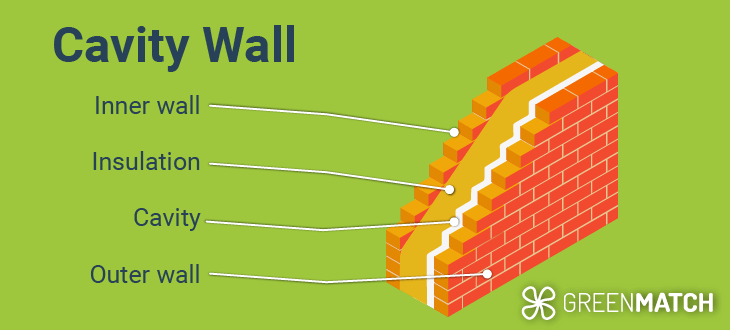
If you're wondering, what is cavity wall insulation? You're in the right place. Cavity walls are common and found in up to 71% of all domestic properties in the UK. They’re mostly seen in homes built after the 1920s and are made up of a brick outer wall and concrete inner wall with a gap or ‘cavity’ in between.
Cavity walls can usually be identified by the brickwork of the property. If the outer bricks have an even pattern and are all laid lengthways, chances are it’s a cavity wall.
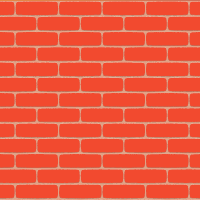
Newly built properties will often have insulation material - such as rigid boards or batts of mineral wool - fitted into the cavity space during the construction process itself. However, the approach for insulating existing properties is different.
Let’s have a look at how it’s done:
- A professional installer inspects the walls to make sure they’re suitable for insulation. Issues like dampness or wall damage must be addressed before taking up the task. Cavity spaces of less than 50mm are not suitable for insulation, and any existing wiring that runs through will need relocating.
- Once the walls pass inspection, the installer drills a series of small holes about 25mm wide through the outer brick wall about a metre apart each. This is to create access into the inner cavity space from outside of the property.
- Then, specialist equipment is used to inject insulation material into the cavity space. The insulation materials commonly used for this job are blown mineral fibre, polystyrene beads, or spray foam insulation.
- After the insulation material is in place, the installer seals the holes in the brickwork with cement, so that there are no noticeable changes to the facade of your property.
There are several types of cavity wall insulation, but the process is relatively quick and straightforward with plenty of pros, as well as some minor cons to consider. We’ve summarized the main points for you:
- Cost-effective: The installation prices for cavity wall insulation are reasonably low in comparison to solid wall insulation.
- Quick installation: The insulation process normally takes no more than 2 to 3 hours to complete, ensuring that installers are out of your hair relatively quickly.
- Undisturbed facade: Cavity wall insulation leaves no visible mark on the outer facade of your home, perfectly preserving the existing look.
- Professional required: Cavity wall insulation is not a job that can be done by yourself, and you will need to employ an accredited installer to carry out the task.
- Potential risks: Poorly installed or sealed cavity wall insulation can lose effectiveness if in contact with moisture. Some types of insulation materials are also prone to sagging over time, reducing their performance.
- Cavity space: You require at least 50mm of cavity space to be able to add insulation. Additionally, filling the cavity with insulation means you’ll no longer have a void to prevent moisture from getting through to the inner wall, so proper sealing is important.
Solid and stud walls
Solid walls are less common in the UK and are mainly found in properties built before the 1920s. These are single or double-layered brick walls with no cavity space in between. Despite making up less than 30% of wall types in the UK, a staggering 97% of solid wall properties lack proper wall insulation and suffer from high energy bills.
Solid walls can also be identified by their brickwork. Normally, the pattern will be less symmetrical and contain brings that are laid lengthways as well as widthways.
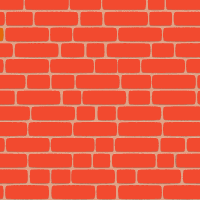
The process of insulating solid walls is very different. Since there is no cavity space, these walls are insulated either internally or externally.
The process is more costly and labour-intensive to undertake and will require a professional installer to make sure the job is done correctly.
External and internal walls
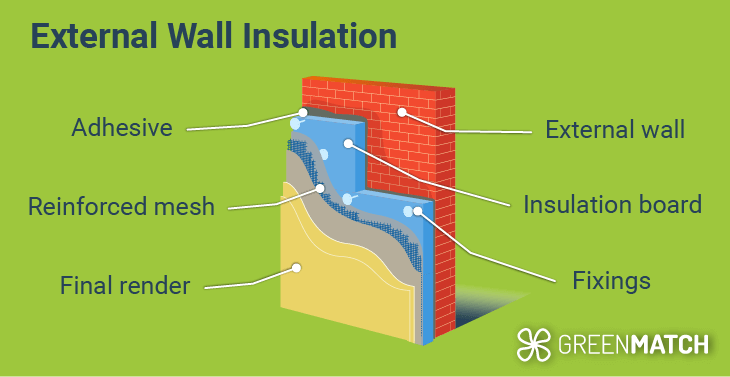
External wall insulation involves fixing insulation material - such as rigid (sheet) insulation - on the outer walls of your property and covering it with render (plaster) and cladding insulation.
While effective, a wall insulation board can be made from synthetic polymers and pollutants. A far more eco-friendly alternative is cork board insulation. Applied in the same way as insulation sheets, but derived from all-natural cork that is sustainably harvested.
An external wall insulation cost is indeed higher than inner wall insulation but comes with its pros and cons worth considering. Let's take a look at some:
- Outside wall insulation can be installed without disrupting your inner home environment.
- It helps fill in cracks and gaps in your outer walls to reduce draught, as well as increase the lifespan of the brickwork by covering it up.
- It can reduce inner wall condensation and dampness issues.
- External wall insulation cladding will change the appearance of your property and may require planning permission to be carried out.
- If gaps around windows and doors aren’t properly sealed, this could encourage ‘cold bridges’, which are weak spots where your insulation is compromised.
- Many common materials used for exterior wall insulation are not so eco-friendly and consume a lot of energy in their production.
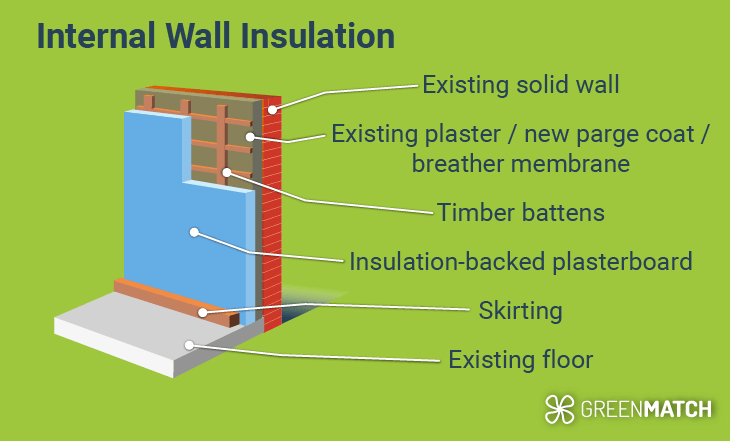
Internal wall insulation is done by fitting rigid (sheet) insulation onto the inside walls of your home and covering it up with plasterboard, or by building stud walls and filling them with mineral wool or another wall insulation roll like fibreglass or sheep wool.
In both cases, any existing dampness and structural issues with the home will have to be addressed before undertaking internal or stud wall insulation.
- Internal insulation is usually cheaper than external insulation.
- Insulating internally provides enhanced soundproofing to your property.
- Due to the insulation being internal, there are no changes to the facade of your home.
- The installation process is complex and disruptive to your home living environment.
- Internal wall insulation will slightly reduce your inner floor space.
- Door frames, skirting boards, and all wall fittings will need to be removed to install the insulation and added back afterwards.
Costs and government grants to insulate your walls
The cost of insulating your walls can vary depending on the type of walls your property has, your home size, the installation complexity, and other property conditions. There are also several government grants and schemes in the UK to help homes upgrade their energy efficiency that you may be eligible for.
To begin with, let's have a look at a typical cavity wall insulation cost in the UK per property type:
| Property type | Cavity wall insulation cost | Annual energy bill savings |
|---|---|---|
| Flat / Apartment | £1000 | £135 |
| Semi-detached home | £2700 | £280 |
| Detached home | £4600 | £485 |
| Mid terrace home | £1500 | £165 |
| Detached bungalow | £2100 | £210 |
Estimating the cost of solid wall insulation is far more difficult to do given the range of factors that influence the price. Nevertheless, a standard 3-bedroom semi-detached home in the UK could expect to pay around £7,500 for internal wall insulation, and up to £12,000 for external wall insulation respectively.
A tip for reducing costs is to carry out insulation when you have other home improvements taking place. You could also insulate your home in parts rather than one go to ease the costs.
How much does it cost to insulate a wall?
Now that we’ve got an overview of what costs we could expect for wall insulation, let's have a deeper look at some other cost-related factors that can influence your overall investment.
For starters, the insulation material you opt for will have a big influence on your overall costs. Typically speaking, the more costly an insulating material, the more effective it is in retaining heat. Options like sheep wool and cork boards may cost more but are far more sustainable and eco-friendly than most synthetic counterparts.
Here is our full cost breakdown for average wall insulation material costs per m2:
| Insulation material | Used for | Average cost (per m2) |
|---|---|---|
| PIR Boards | Internal / External | £5 – £15 |
| Fibreglass | Internal | £10 |
| Polystyrene (EPS) Boards | Internal / External | £10 |
| Cellulose | Internal | £10 - £12 |
| Mineral (Glass) Wool | Internal | £13 - £17.5 |
| Cork boards | Internal / External | £17 - £22 |
| Sheep wool | Internal | £17.5 - £22 |
| Mineral (Rock) Wool | Internal | £18.2 |
| Polyurethane Boards | Internal / External | £21.5 |
Keep in mind that these costs can fluctuate based on the availability and thermal efficiency of materials. For example, low U-value insulation in the UK costs more as such materials are better at resisting heat transfer. Home insulation has been a forefront focus for homes all across the UK, and as a result, some material prices may increase if they’re in popular demand or difficult to produce.
What are the available grants for wall insulation?
There are available wall insulation government grants in the UK through two key schemes; The Great British Insulation Scheme and the ECO4 Scheme (Energy Company Obligation). Both initiatives aim to offer reduced-cost or free home upgrades to low-income and fuel-poor households throughout the country. Both schemes are currently active until March 2026.
Let's take a closer look at each scheme:
- The Great British Insulation Scheme aims to provide qualifying households with one-off insulation measures, including solid and cavity wall insulation grants. This ‘single measure’ approach allows the scheme to widen its reach across the UK. Upgrades are decided after a retrofit assessment of your property to determine the best measure. You can apply directly for the scheme through the UK government portal.
- The ECO4 Scheme is slightly different, as it rather obliges energy companies themselves to assist qualifying households. The scheme contains a variety of energy efficiency upgrades, including internal and external wall insulation grants. You can reach out to your energy provider to apply and determine whether you qualify.
In both cases, households in low-income categories, or those with an Energy Performance Certificate (EPC) rating under D are likely to qualify for cavity wall insulation grants, or solid wall grant options. If one or more members of a household receive certain government benefits, they may also be eligible for wall insulation assistance.
Insulating walls: regulations and requirements
In the UK, there are several regulations and requirements in place to ensure wall insulation jobs are carried out professionally and effectively. This also helps make sure that your investment is worth every penny. Here are some of the key points to look out for:
- Permissions and notices: For external wall insulation, planning permission is required as the appearance of your property will be altered. For cavity wall insulation, a building notice needs to be submitted to the relevant local authority, but a registered professional installer normally does this on your behalf.
- Insulation thickness: For cavity walls, the UK government recommends at least 150mm cavity wall insulation to be in place. For internal insulation, stud walls should be insulated with at least 120mm of standard (blanket) insulation. For external walls, rigid sheet insulation should be between 50mm to 100mm in thickness.
- Installer accreditation: The PAS 2030-2035 is a UK government-backed certification that energy-efficiency installers must be certified and compliant with. Working with a professional accredited installer will help make sure that the job is carried out correctly.
- Competent person scheme: The UK government has regulations to ensure that installers are members of schemes that identify them as properly certified and competent in their job. Some examples of these schemes are CIGA or Stroma. This also helps make sure you receive a professional installation.
Best wall insulation materials
The best wall insulation material for the job will hinge on several factors, such as your wall type (cavity or solid), available budget, installation complexity and personal preferences.
Nevertheless, some materials are better suited for certain wall insulation purposes than others, including some that can be installed DIY. In this section, we will break down the key wall insulation materials you can find, and which options are best suited for you.
Insulation rolls

Insulation rolls are blankets of woolly fibrous material that can be fitted behind stud walls when carrying out internal wall insulation. It’s generally the most affordable and market-wide available insulation material.
Insulation rolls tend to be on the more eco-friendly side, with fully natural and sustainable options like sheep wool, or options with minimal environmental impact such as mineral wool (rock and glass) or fibreglass rolls.
- Popular, affordable and easy to find.
- Can be installed DIY.
- More environmentally friendly than other alternatives.
- Not suitable for external wall insulation.
- Requires up to 100mm of stud wall insulation, reducing your floor space.
- Loses insulation capacity when moist or compressed.
Insulation boards

Rigid boards are a range of insulation panels renowned for their high heat retention, making them one of the most effective insulation materials on the market. These are best used during internal or external wall insulation but are not suitable for cavity walls.
Most thermal insulation boards - like PIR or Polyurethane - are made from synthetic polymers that are energy-intensive to produce, difficult to recycle, and potentially unhealthy to live around.
Luckily, eco-friendly alternatives like cork board are also available as a more environmentally conscious choice. Foil insulation board is another eco-friendly, cost-effective and easy-to-obtain alternative that is suitable for both internal and external insulation.
- High heat insulation capability.
- Easy installation, potentially even DIY.
- Less thickness is required, saving you floor space on stud wall insulation.
- More expensive than most other alternatives.
- Most options are unsustainable or made from plastics and polymers.
- Synthetic boards release harmful fumes when exposed to heat or fire.
Foam insulation

Spray foam insulation is a highly effective insulator when it comes to heat retention. It’s normally used in cavity wall insulation by being sprayed into the space through a series of externally drilled holes.
Cavity wall foam insulation comes in liquid form and expands in the cavity space when applied. Unfortunately, it’s considered one of the least sustainable options on the market, often even containing toxic carcinogens like formaldehyde that are dangerous to live around.
- One of the highest heat retention capabilities.
- Easy and quick installation.
- Robust, and with a long lifespan.
- Unsustainable, unrecyclable, and potentially toxic.
- More expensive than other insulation options.
- Potentially releases harmful fumes and carcinogens.
Should you insulate walls by yourself?
While it’s true that a DIY insulation installation can cost two to three times less than a professional, there is no doubt that the benefits provided by a certified expert installer greatly outweigh the short-term financial gain of a self-done installation.
For cavity wall insulation - or the use of insulation materials like blown fibre or spray foam - DIY insulation is simply not possible and a professional is required. As for all other cases where you can install insulation yourself, here’s why you should still consider a professional:
- Safety first: Some insulation materials can be dangerous to work with due to skin and eye irritation or the risk of inhaling fumes. Professional installers are trained and equipped to handle these cases safely, protecting you and your family from potential health risks and handling a job in the most effective and eco-friendly manner possible.
- Speedy job: Professional installers can tackle your wall insulation in a fraction of the time it would take for a DIY project. This minimizes disruption to your home and lets you get back to your routine quickly.
- Expert solutions: Qualified installers are highly skilled in their field. They can identify and address problems like drafts, dampness, and structural issues that might affect insulation performance and solve them before they become larger issues. They’ll also ensure your wall insulation meets all government regulations.
While it’s evident that a professional installer is your best bet, finding one can be harder than expected. With the sea of professional installers available on the market, you could easily spend countless hours surfing websites and scheduling phone calls to land the perfect scenario. Here at GreenMatch UK, we want to free you of this stress.
Simply fill out our quick 30-second form and receive up to 3 free quotes from our trusted network of local accredited installers, completely free of charges or obligations to follow through. Click the button below to begin and land the best bargain for your home today!
- Describe your needs
- Get free quotes
- Choose the best offer
It only takes 30 seconds



FAQ
The cost of wall insulation depends on many factors, such as your wall type and conditions, property size, and chosen insulation material. For standard cavity wall insulation in a 3-bedroom semi-detached house, you can expect to pay around £2700 for a full job.
The type of insulation you need is largely determined by the type of walls your home has; cavity or solid. Cavity walls usually use blown mineral fibre, polystyrene beads, or spray foam insulation, while external walls will use rigid (sheet) insulation. Inner stud walls can use a wider range of materials depending on your budget and home conditions. It’s best to consult a professional insulation expert to make the best choice.
Cavity wall insulation works by an installer drilling a series of small holes from the outer wall to reach the cavity space inside. Then, specialist equipment is used to inject insulation material into the cavity space, before sealing up the holes with concrete for a seamless finish.
To insulate a wall, you need to first identify the type of wall you have; solid or cavity. The insulation approach and materials will largely be decided by this factor. You will also need to ensure that you are meeting government-set regulations and requirements, including necessary permissions. It’s highly advised to work with an accredited installer to make sure the job is done professionally.

Akif is a copywriter at GreenMatch since 2023. With a keen interest in community sustainability, green solutions and the role of digital media in identifying climate trends, he aims to hone in on his background in International Studies and Digital Media to provide a multidisciplinary approach to written content rooted in credible research and accuracy.
- Cavity Wall Insulation
- Best Cavity Wall Insulation
- Retrofit Cavity Wall Insulation
- Cavity Wall Insulation Costs
- Cavity Wall Insulation Beads
- Cavity Wall Insulation Damp
- Cavity Wall Insulation Northern Ireland
- Old House
- Party Wall Cavity Insulation
- Cavity Wall U-value
- Sound Proof
- Cavity Wall Insulation Check
- Cavity Wall Insulation Companies
- Foam Cavity Wall Insulation
- E.ON Cavity Wall Insulation
- Government Cavity Wall Insulation
- Non-Cavity
- How Long Does Cavity Wall Insulation Last
- Install Cavity Wall Insulation
- Cavity Wall Costs For 3 Bed Semi
- Cavity Wall Insulation Alternatives
- Full Fill Insulation
- Cavity Wall Insulation New Build
- Injected Cavity Wall Insulation
- Pumped
- Cavity Wall Insulation Introduction
- External Wall Insulation
- External Wall Insulation Thickness
- External Wall Insulation Cost
- External Wall Insulation Disadvantages
- External Insulation Render
- Single Brick Wall Insulation
- External Insulation Render Cost
- External Wall Insulation Companies
- Materials
We strive to connect our customers with the right product and supplier. Would you like to be part of GreenMatch?

